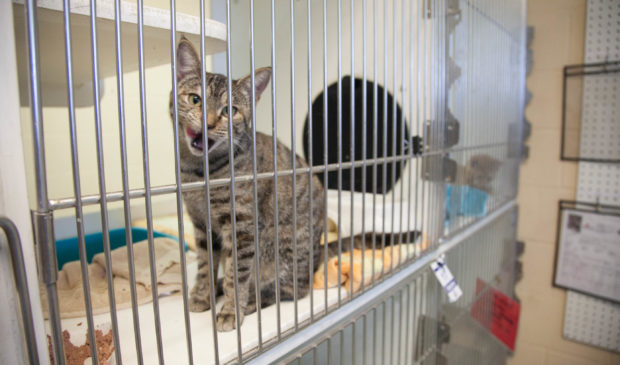Austin Animal Center faces questions about monthly update
Thursday, May 12, 2022 by
Willow Higgins Alongside shelters nationwide, the Austin Animal Center has been struggling with staffing shortages and soaring populations of shelter animals – a situation that was evident in the shelter’s monthly update to the Animal Advisory Commission.
In April, a total of 1,067 animals were brought to the shelter, while 419 were adopted and 132 cats, dogs or birds were returned to their owners.
Ninety-three dogs were transferred to three out-of-state rescue partners, which helps the shelter handle its capacity. Ninety-nine percent of the eligible animals in the shelter were spayed or neutered as of last month; additionally, the shelter arranged 27 orthopedic surgeries and 23 specialty surgeries.
The shelter has been working, as it always does, to engage volunteers to help with the workload. In April, 278 volunteers donated 3,331 hours of service; 114 volunteers were newcomers to the shelter.
The shelter also works closely with fosters, people who care for adoptable shelter animals in their own homes. Many animals have difficulties coping with the loud and stressful nature of a city shelter. However, when fostered in a private home they come out of their shells, making those animals more likely to find forever adoptive homes. Fosters also help relieve the shelter’s space crunch when all available kennels are occupied. About 150 people fostered animals in the month of April and more than 100 others applied to be new fosters, bumping the number of approved fosters to over 800.
“One of the commenters had just talked about the need for more fosters and in your report, it says there are 235 animals in foster care and there are 810 approved fosters. So is anything being done to kind of try to get the other 600 or so more engaged and taking animals?” Commissioner Lisa Mitchell asked.
Jason Garza of Animal Services, who presented the update to the commission, said that staff members do their best to regularly reach out to approved foster parents and engage them, but they don’t always hear back, or people’s criteria have changed. They work to accommodate the needs of potential fosters as best they can to find animals a home away from the shelter.
Commissioner Ryan Clinton asked about animal deaths in the shelter he saw reported versus claims he’d seen on social media.
“I know that social media can be wrong, but on social media there have been reports of dog deaths in the shelter and also deaths on transports, but none of those are reported in the data. I was wondering if those social media reports were true, and if so why isn’t it being reported?” Clinton asked.
The report listed two deaths of kittens in the shelter; Garza explained that one pit bull terrier had also died, a death that didn’t make it into the report due to technical or administrative issues. A total of seven shelter animals died last month, but only dogs and cats are required to be reported.
Garza also mentioned that the shelter has provided over 1,600 different basic pet assistance items to pet parents who have asked for support from the shelter. Commissioner Palmer Neuhaus asked for a more specific understanding of what type of items these are.
Garza explained that it is mostly food; the number provided also includes donations distributed by outreach personnel who interface with homeless communities that may include pets.
“We provide food, crates, any sort of supplies that individuals may need … when they say, ‘we were looking at surrendering this dog because we can’t feed it,’” Garza said.
Neuhaus requested more information in future reports about how the data points provided at monthly meetings compare to previous metrics. Garza said the staff can begin to weave additional data into their presentation for the purpose of comparison.
“It’s still really difficult to gauge when you say, we did X number of surgeries this month. Is that better or worse than last month? Is that better or worse than this same month last year? Can we start getting some of that information so when you give us your verbal report, we have some comparisons to draw some conclusions about what exactly that means?” Neuhaus requested.
Photo made available through a Creative Commons license.
The Austin Monitor’s work is made possible by donations from the community. Though our reporting covers donors from time to time, we are careful to keep business and editorial efforts separate while maintaining transparency. A complete list of donors is available here, and our code of ethics is explained here.
You're a community leader
And we’re honored you look to us for serious, in-depth news. You know a strong community needs local and dedicated watchdog reporting. We’re here for you and that won’t change. Now will you take the powerful next step and support our nonprofit news organization?




